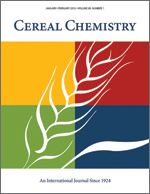
Cereal Chem 53:956 - 963. | VIEW
ARTICLE
Classifying Malt by Sieving and Air Centrifuging-Elutriating Techniques.
Y. Pomeranz, K. F. Finney, L. C. Bolte, and M. D. Shogren. Copyright 1976 by the American Association of Cereal Chemists, Inc.
Commercial barley malt flour was separated by conventional sieving and by air centrifugation-elutriation on a laboratory microclassifier according to particle size into fractions of various compositions. Scanning electron micrographs were used to determine particle size of, and to characterize particles in, separated fractions. The fractions varied in protein and mineral contents (total ash, K, P, Mg, Ca, Mn and Zn) and in amylolytic activity (alpha-amylase and diastatic power). The original malt and each of the nine fractions were added at four alpha-amylase levels to ano-sugar dough to provide the source of fermentable sugars in breadmaking. Adding malt decreased water absorption (up to 1.6%) and mixing time (up to 3/8 min). Added on an equivalent alpha-amylase basis, the original malt and all malt fractions increased loaf volume equally. Loaf volume of bread (100 g-flour) baked without added sugar or malt was 408 ; adding 27, 54, 81, or 108 D.U. (dextrinizing units, 20 C), respectively, increased average loaf volume to 881, 928, 933, and 935 ; 54 D.U. was optimum. Contribution of malt to bread quality was unaffected by particle size or composition of the malt, provided equivalent alpha-amylase was added. Increasing alpha-amylase to twice the optimum had no adverse effects on dough-handling properties, but produced bread with slightly open crumb grain.